A Sensor-Based mHealth Platform for Remote Monitoring and Intervention of Frailty Patients at Home
Abstract
1. Introduction
2. User Needs of Citizens in Risk of Frailty
3. The FRAIL Project
4. Personal and Home Sensing Platform
4.1. Fall Detection
4.1.1. Smart Sensor for the Impact Detection
4.1.2. The Fall Detection Application Program Interface (API) in the Smartwatch
4.2. Smart Vest
4.2.1. Smart Device for Respiratory and Physical Activity Monitoring
4.2.2. Elastic Vest
4.2.3. The API for Respiratory and Physical Activity Monitoring
4.3. Smartwatch
- Medication: reminders of pending actions and the history of the medication taken.
- Agenda: shows pending activities and appointments, as well as a history of past activities.
- Gamification: reminders of games scheduled. Games are displayed in the gamification system.
- Breathing: shows real-time data about user’s breathing rate.
- Heartbeats: displays current heart rate of the user.
- Alerts: the smartwatch offers the possibility of sending a warning in case of emergency. To alert, the user presses and holds the display for three seconds. A countdown confirms the delivery of the alert.
5. Evaluation
5.1. Validation of the Sensors in Laboratory Setting
- Fall-free activities: walking, climbing stairs, descending stairs, picking up an object from the ground, sitting in a chair.
- Fall activities: falling to the floor by first supporting the knees, falling to the floor from a chair, falling to the floor from a bench (simulation of falling from a bed).
5.2. Testing of the Devices in a Real Environment
- over 65 years old,
- living in an autonomous way but assisted by formal caregivers,
- risk of falls, and
- physical impairments (e.g., slowness or weakness) causing low physical activity.
- bedridden patients,
- reduced mobility (wheelchair use), and
- cognitive impairment.
5.2.1. Key Performance Indicators: Description and Measurement
5.2.2. Usability and User Acceptance
5.2.3. Technostress and USE-Q Correlations
6. Discussion
7. Conclusions
Author Contributions
Funding
Institutional Review Board Statement
Informed Consent Statement
Data Availability Statement
Conflicts of Interest
References
- World Health Organization (WHO). Ageing and Health. Fact Sheet. Updated October 2021. Available online: https://www.who.int/news-room/fact-sheets/detail/ageing-and-health (accessed on 22 October 2021).
- Chen, X.; Mao, G.; Leng, S.X. Frailty syndrome: An overview. Clin. Interv. Aging 2014, 9, 433–441. [Google Scholar] [PubMed]
- Collard, R.M.; Boter, H.; Schoevers, R.A.; Oude Voshaar, R.C. Prevalence of frailty in community-dwelling older persons: A systematic review. J. Am. Geriatr. Soc. 2012, 60, 1487–1492. [Google Scholar] [CrossRef] [PubMed]
- Navarrete-Villanueva, D.; Gómez-Cabello, A.; Marín-Puyalto, J.; Moreno, L.A.; Vicente-Rodríguez, G.; Casajús, J.A. Frailty and physical fitness in elderly people: A systematic review and meta-analysis. Sports Med. 2021, 51, 143–160. [Google Scholar] [CrossRef] [PubMed]
- Adja, K.Y.C.; Lenzi, J.; Sezgin, D.; O’Caoimh, R.; Morini, M.; Damiani, G.; Buja, A.; Fantini, M.P. The importance of taking a patient-centered, community-based approach to preventing and managing frailty: A public health perspective. Front. Public Health 2020, 8, 599170. [Google Scholar] [CrossRef] [PubMed]
- Gill, T.M.; Gahbauer, E.A.; Allore, H.G.; Han, L. Transitions between frailty states among community-living older persons. Arch. Intern. Med. 2006, 166, 418–423. [Google Scholar] [CrossRef]
- Gallucci, A.; Trimarchi, P.D.; Abbate, C.; Tuena, C.; Pedroli, E.; Lattanzio, F.; Stramba-Badiale, M.; Cesari, M.; Giunco, F. ICT technologies as new promising tools for the managing of frailty: A systematic review. Aging Clin. Exp. Res. 2021, 33, 1453–1464. [Google Scholar] [CrossRef]
- Silva, C.R.D.T.; Carvalho, K.M.D.; Figueiredo, M.D.L.F.; Silva-Júnior, F.L.; Andrade, E.M.L.R.; Nogueira, L.T. Health promotion of frail elderly individuals and at risk of frailty. Rev. Bras. Enferm. 2019, 72, 319–327. [Google Scholar] [CrossRef]
- Dekker-van Weering, M.; Jansen-Kosterink, S.; Frazer, S.; Vollenbroek-Hutten, M. User experience, actual use, and effectiveness of an information communication technology-supported home exercise program for pre-frail older adults. Front. Med. 2017, 4, 208. [Google Scholar] [CrossRef]
- O’Caoimh, R.; Molloy, D.W.; Fitzgerald, C.; van Velsen, L.; Cabrita, M.; Nassabi, M.H.; de Vette, F.; Dekker-van Weering, M.; Jansen-Kosterink, S.; Kenter, W.; et al. Healthcare recommendations from the personalised ICT supported service for independent living and active ageing (PERSSILAA) study. In Proceedings of the 3rd International Conference on Information and Communication Technologies for Ageing Well and e-Health (ICT4AWE), Porto, Portugal, 28–29 April 2017; Volume 2, pp. 91–103. [Google Scholar]
- Pradeep Kumar, D.; Toosizadeh, N.; Mohler, J.; Ehsani, H.; Mannier, C.; Laksari, K. Sensor-based characterization of daily walking: A new paradigm in pre-frailty/frailty assessment. BMC Geriatr. 2020, 20, 164. [Google Scholar] [CrossRef]
- Anabitarte-García, F.; Reyes-Gonzalez, L.; Rodriguez-Cobo, L.; Fernández-Viadero, C.; Somonte-Segares, S.; Díez-Del-Valle, S.; Mandaluniz, E.; García-García, R.; López-Higuera, J.M. Early diagnosis of frailty; technological and non-intrusive devices for clinical detection. Ageing Res. Rev. 2021, 70, 101399. [Google Scholar] [CrossRef]
- Kim, B.; McKay, S.M.; Lee, J. Consumer-Grade Wearable Device for Predicting Frailty in Canadian Home Care Service Clients: Prospective Observational Proof-of-Concept Study. J. Med. Internet Res. 2020, 22, e19732. [Google Scholar] [CrossRef] [PubMed]
- Apsega, A.; Petrauskas, L.; Alekna, V.; Daunoraviciene, K.; Sevcenko, V.; Mastaviciute, A.; Vitkus, D.; Tamulaitiene, M.; Griskevicius, J. Wearable Sensors Technology as a Tool for Discriminating Frailty Levels During Instrumented Gait Analysis. Appl. Sci. 2020, 10, 8451. [Google Scholar] [CrossRef]
- Araujo, F.; Nogueira, M.; Silva, J.; Rego, S. A Technological-Based Platform for Risk Assessment, Detection, and Prevention of Falls among Home-Dwelling Older Adults: Protocol for a Quasi-Experimental Study. JMIR Res. Protoc. 2021, 10, e25781. [Google Scholar] [CrossRef] [PubMed]
- Abril-Jiménez, P.; Lacal, J.R.; de los Ríos Pérez, S.; Páramo, M.; Colomer, J.B.M.; Waldmeyer, M.T.A. Ageing-friendly cities for assessing older adults’ decline: IoT-based system for continuous monitoring of frailty risks using smart city infrastructure. Aging Clin. Exp. Res. 2020, 32, 663–671. [Google Scholar] [CrossRef] [PubMed]
- Meng, F.; Guo, X.; Peng, Z.; Ye, Q.; Lai, K.-H. Trust and elderly users’ continuance intention regarding mobile health services: The contingent role of health and technology anxieties. Inf. Technol. People 2021, in press. [Google Scholar] [CrossRef]
- FRAIL: Interventions on Frailty and Ageing Risks for Elderly People Based on ICT Tools. EUROSTARS, EU H2020 Program, 2017–2020. Available online: https://www.era-learn.eu/network-information/networks/eurostars-2/eurostars-2-cut-off-6/interventions-on-frailty-and-ageing-risks-for-elderly-people-based-on-ict-tools (accessed on 22 October 2021).
- NICE Guidance. Available online: https://www.nice.org.uk/guidance (accessed on 22 October 2021).
- European Innovation Partnership on Active and Healthy Ageing (EIP-AHA). Action Plan on Prevention and Early Diagnosis of Frailty and Functional Decline, Both Physical and Cognitive, in Older People. 2012. Available online: https://ec.europa.eu/eip/ageing/library/action-plan-prevention-and-early-diagnosis-frailty-and-functional-decline-both-physical-and_en.html (accessed on 22 October 2021).
- Naranjo-Hernández, D.; Roa-Romero, L.M.; Reina-Tosina, L.J.; Estudillo-Valderrama, M.A. Personalization and Adaptation to the Medium and Context in a Fall Detection System. IEEE Trans. Inf. Technol. Biomed. 2012, 16, 264–271. [Google Scholar] [CrossRef] [PubMed]
- Estudillo-Valderrama, M.A.; Roa-Romero, L.M.; Reina-Tosina, L.J.; Barbarov-Rostán, G.; Naranjo-Hernández, D. Lessons learned from the development of an affordable fall detection system for mHealth. J. Biomed. Eng. Inform. 2015, 1, 59–69. [Google Scholar] [CrossRef][Green Version]
- Naranjo-Hernández, D.; Roa-Romero, L.M.; Reina-Tosina, L.J.; Estudillo-Valderrama, M.A. SoM: A Smart Sensor for Human Activity Monitoring and Assisted Healthy Ageing. IEEE Trans. Biomed. Eng. 2012, 59, 3177–3184. [Google Scholar] [CrossRef]
- Naranjo-Hernández, D.; Reina-Tosina, L.J.; Roa-Romero, L.M.; Barbarov-Rostán, G.; Talaminos-Barroso, A.; Cejudo-Ramos, P.; Márquez-Martín, E.; Ortega-Ruiz, F. Smart Vest for Respiratory and Physical Activity Monitoring in COPD Patients. In Proceedings of the 15th Mediterranean Conference on Medical and Biological Engineering and Computing (MEDICON), Coimbra, Portugal, 26–28 September 2019; Volume 76, pp. 447–454. [Google Scholar]
- Naranjo-Hernández, D.; Talaminos-Barroso, A.; Reina-Tosina, J.; Roa-Romero, L.M.; Barbarov-Rostan, G.; Cejudo-Ramos, P.; Márquez-Martín, E.; Ortega-Ruiz, F. Smart vest for respiratory rate monitoring of COPD patients based on non-contact capacitive sensing. Sensors 2018, 18, 2144. [Google Scholar] [CrossRef] [PubMed]
- Wang, Z.; Ramamoorthy, V.; Gal, U.; Guez, A. Possible life saver: A review on human fall detection technology. Robotics 2020, 9, 55. [Google Scholar] [CrossRef]
- Liu, H.; Allen, J.; Zheng, D.; Chen, F. Recent development of respiratory rate measurement technologies. Physiol. Meas. 2019, 40, 07TR01. [Google Scholar] [CrossRef] [PubMed]
- Bhattacharya, D.; Acharya, K.A. A platform for free weight exercise monitoring using passive tags. Lect. Notes Electric. Eng. 2020, 660, 205–214. [Google Scholar]
- Lund, A.M. Measuring usability with the USE questionnaire. Usability Interface 2001, 8, 3–6. [Google Scholar]
- Cohen, S.; Kamarck, T.; Mermelstein, R. A global measure of perceived stress. J. Health Soc. Behav. 1983, 24, 385–396. [Google Scholar] [CrossRef]
- Ruiz-Ruiz, L.; Jimenez, A.R.; Garcia-Villamil, G.; Seco, F. Detecting fall risk and frailty in elders with inertial motion sensors: A survey of significant gait parameters. Sensors 2021, 21, 6918. [Google Scholar] [CrossRef]
- Usmani, S.; Saboor, A.; Haris, M.; Khan, M.A.; Park, H. Latest research trends in fall detection and prevention using machine learning: A systematic review. Sensors 2021, 21, 5134. [Google Scholar] [CrossRef]
- Shu, F.; Shu, J. An eight-camera fall detection system using human fall pattern recognition via machine learning by a low-cost android box. Sci. Rep. 2021, 11, 2471. [Google Scholar] [CrossRef]
- Tošić, A.; Hrovatin, N.; Vičič, J. Data about fall events and ordinary daily activities from a sensorized smart floor. Data Brief. 2021, 37, 107253. [Google Scholar] [CrossRef]
- Singh, A.; Rehman, S.U.; Yongchareon, S.; Chong, P.H.J. Sensor Technologies for Fall Detection Systems: A Review. IEEE Sens. J. 2020, 20, 6889–6919. [Google Scholar] [CrossRef]
- Wu, J.; Wang, J.; Zhan, A.; Wu, C. Fall detection with cnn-casual lstm network. Information 2021, 12, 403. [Google Scholar] [CrossRef]
- De Fazio, R.; Stabile, M.; De Vittorio, M.; Velázquez, R.; Visconti, P. An overview of wearable piezoresistive and inertial sensors for respiration rate monitoring. Electronics 2021, 10, 2178. [Google Scholar] [CrossRef]
- Klum, M.; Urban, M.; Pielmus, A.-G.; Orglmeister, R. Wearable Impedance Pneumography. Curr. Dir. Biomed. 2020, 6, 233–236. [Google Scholar]
- Harbour, E.; Lasshofer, M.; Genitrini, M.; Schwameder, H. Enhanced breathing pattern detection during running using wearable sensors. Sensors 2021, 21, 5606. [Google Scholar] [CrossRef] [PubMed]
- Teixeira, E.; Fonseca, H.; Diniz-Sousa, F.; Veras, L.; Boppre, G.; Oliveira, J.; Pinto, D.; Alves, A.J.; Barbosa, A.; Mendes, R.; et al. Wearable devices for physical activity and healthcare monitoring in elderly people: A critical review. Geriatrics 2021, 6, 38. [Google Scholar] [CrossRef] [PubMed]
- Davoudi, A.; Mardini, M.T.; Nelson, D.; Albinali, F.; Ranka, S.; Rashidi, P.; Manini, T.M. The effect of sensor placement and number on physical activity recognition and energy expenditure estimation in older adults: Validation study. JMIR Mhealth Uhealth 2021, 9, e23681. [Google Scholar] [CrossRef] [PubMed]
- Murakami, H.; Kawakami, R.; Nakae, S.; Yamada, Y.; Nakata, Y.; Ohkawara, K.; Sasai, H.; Ishikawa-Takata, K.; Tanaka, S.; Miyachi, M. Accuracy of 12 wearable devices for estimating physical activity energy expenditure using a metabolic chamber and the doubly labeled water method: Validation study. JMIR Mhealth Uhealth 2019, 7, e13938. [Google Scholar] [CrossRef]
- Alharbi, M.; Straiton, N.; Smith, S.; Neubeck, L.; Gallagher, R. Data management and wearables in older adults: A systematic review. Maturitas 2019, 124, 100–110. [Google Scholar] [CrossRef]
- Zelman, S.; Dow, M.; Tabashum, T.; Xiao, T.; Albert, M.V. Accelerometer-Based Automated Counting of Ten Exercises without Exercise-Specific Training or Tuning. J. Healthc. Eng. 2020, 2020, 8869134. [Google Scholar] [CrossRef]
- Ishii, S.; Yokokubo, A.; Luimula, M.; Lopez, G. Exersense: Physical exercise recognition and counting algorithm from wearables robust to positioning. Sensors 2021, 21, 91. [Google Scholar] [CrossRef]
- Skawinski, K.; Montraveta-Roca, F.; Findling, R.D.; Sigg, S. Workout Type Recognition and Repetition Counting with CNNs from 3D Acceleration Sensed on the Chest. Lect. Notes Comput. Sci. 2019, 11506, 347–359. [Google Scholar]
- Venek, V.; Kremser, W.; Stöggl, T. Towards a live feedback training system: Interchangeability of orbbec persee and microsoft kinect for exercise monitoring. Designs 2021, 5, 30. [Google Scholar] [CrossRef]
- Morris, D.; Saponas, T.S.; Guillory, A.; Kelner, I. RecoFit: Using a wearable sensor to find, recognize, and count repetitive exercises. In Proceedings of the 1st Conference on Human Factors in Computing Systems, Toronto, ON, Canada, 26 April–1 May 2014; pp. 3225–3234. [Google Scholar]
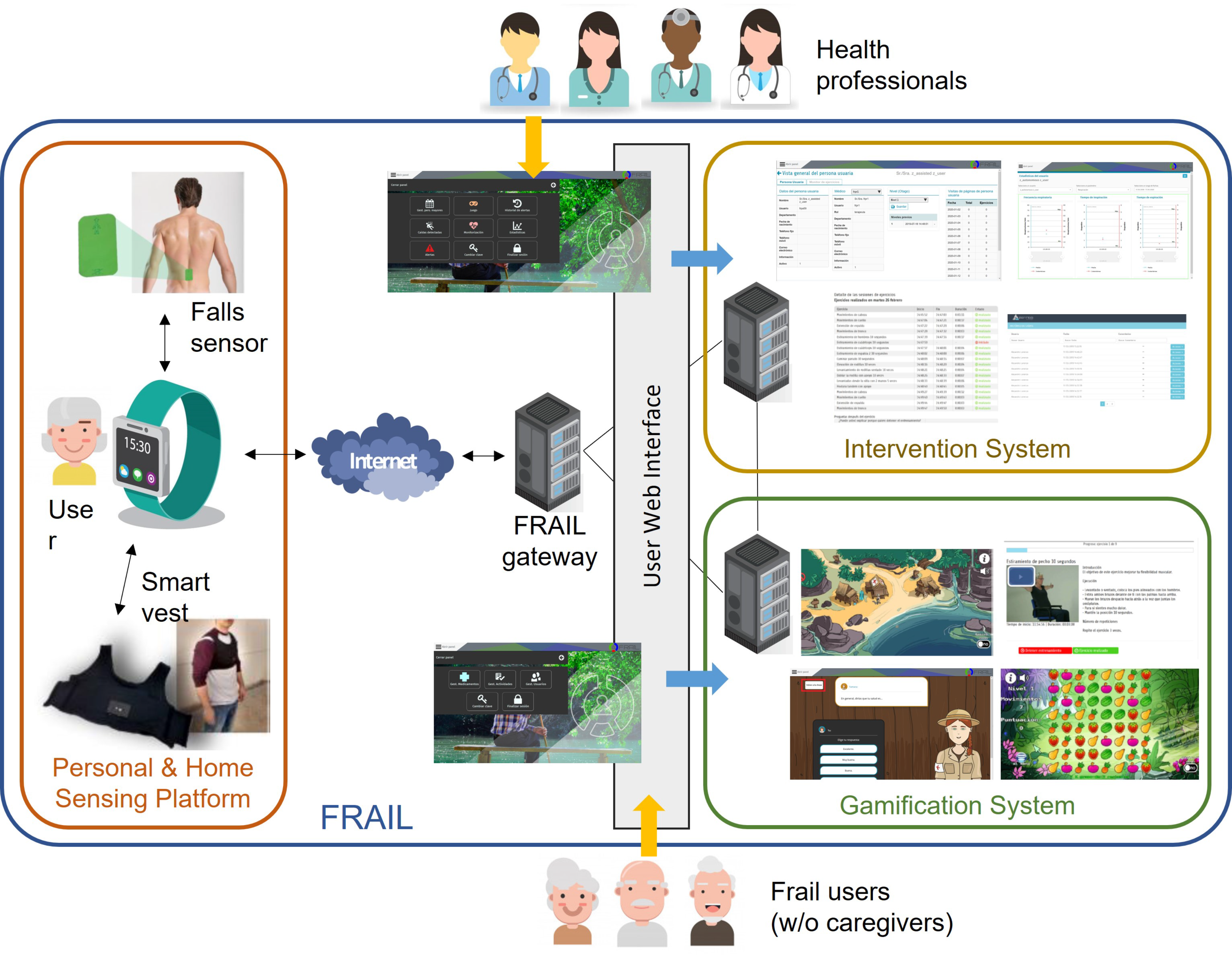

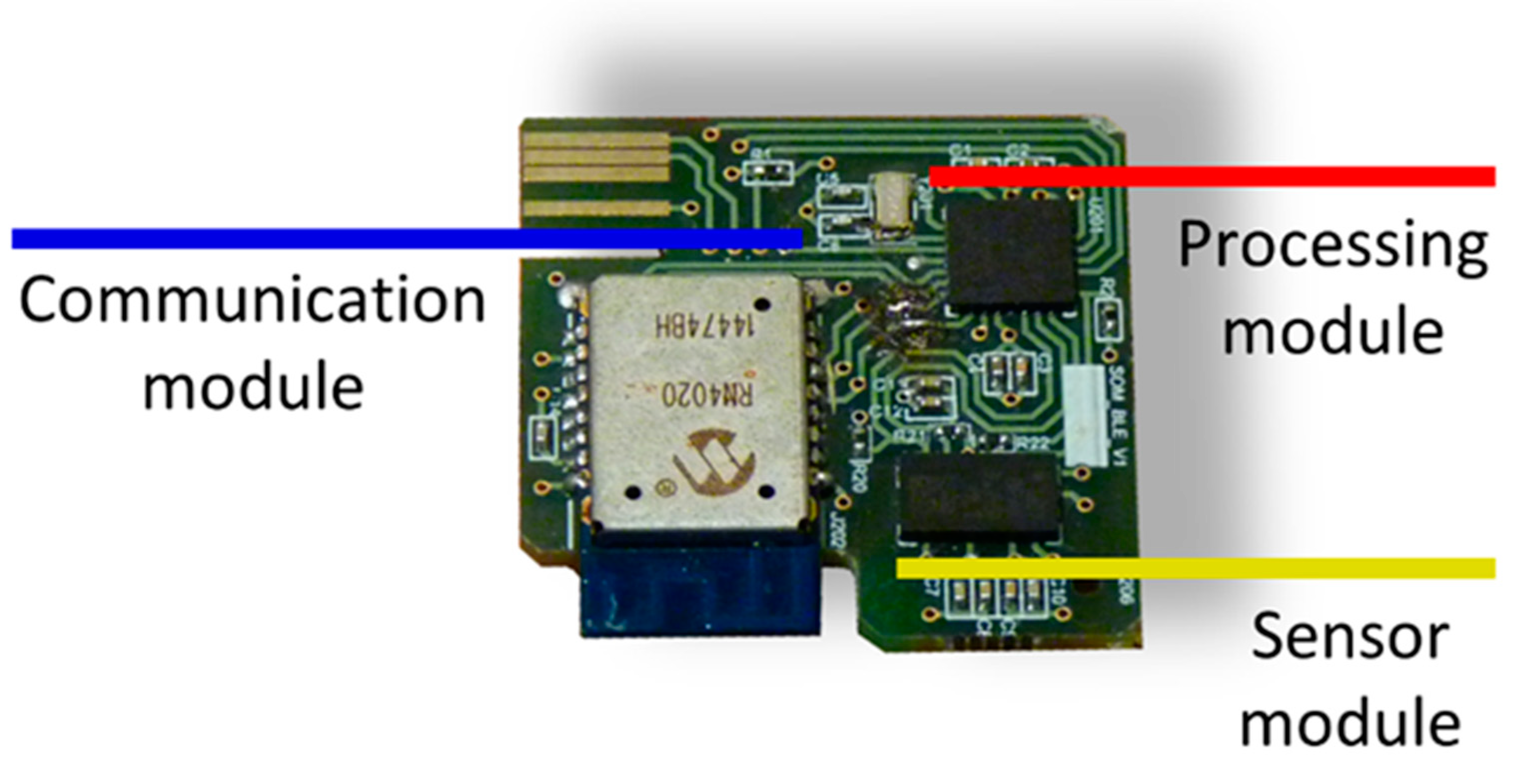
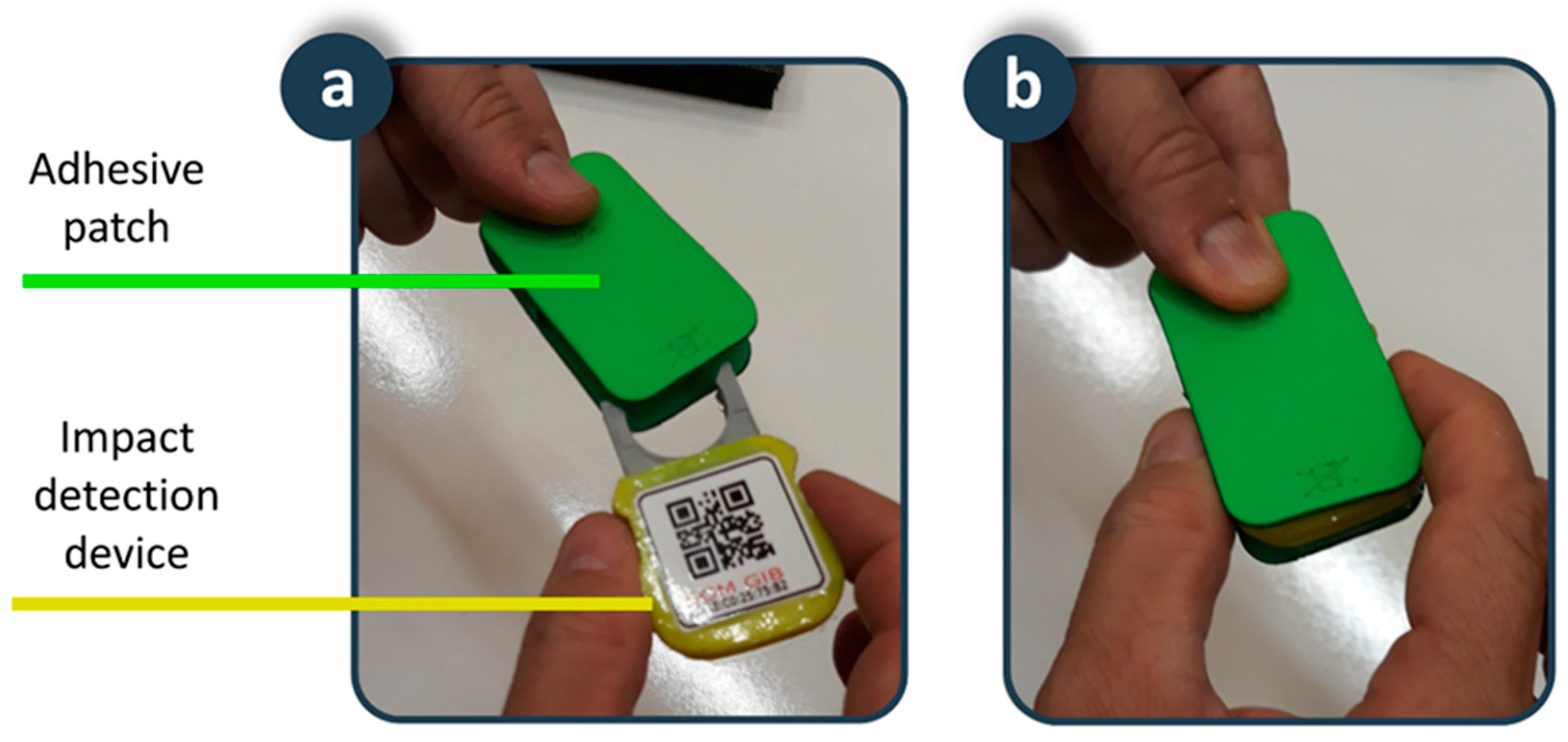



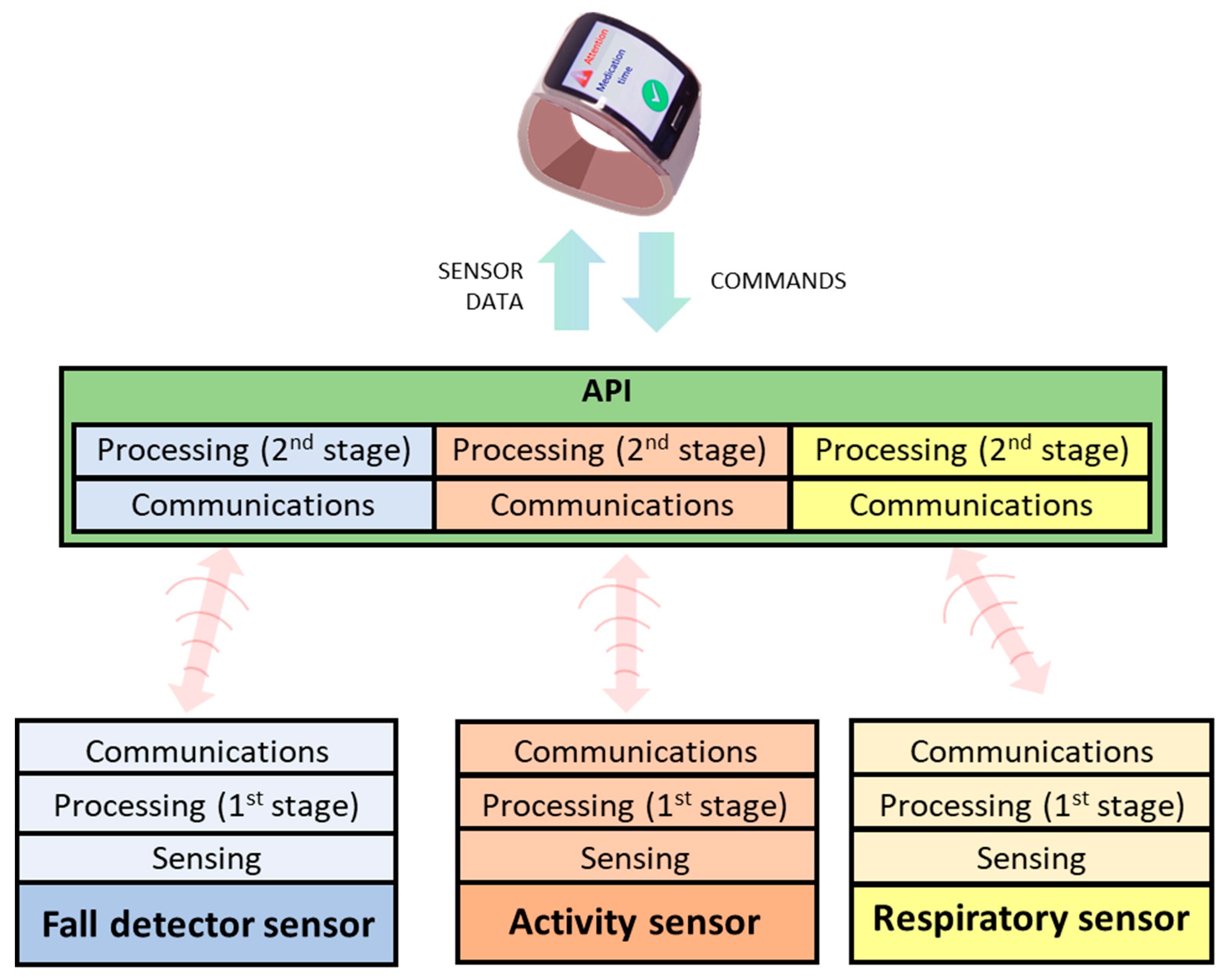
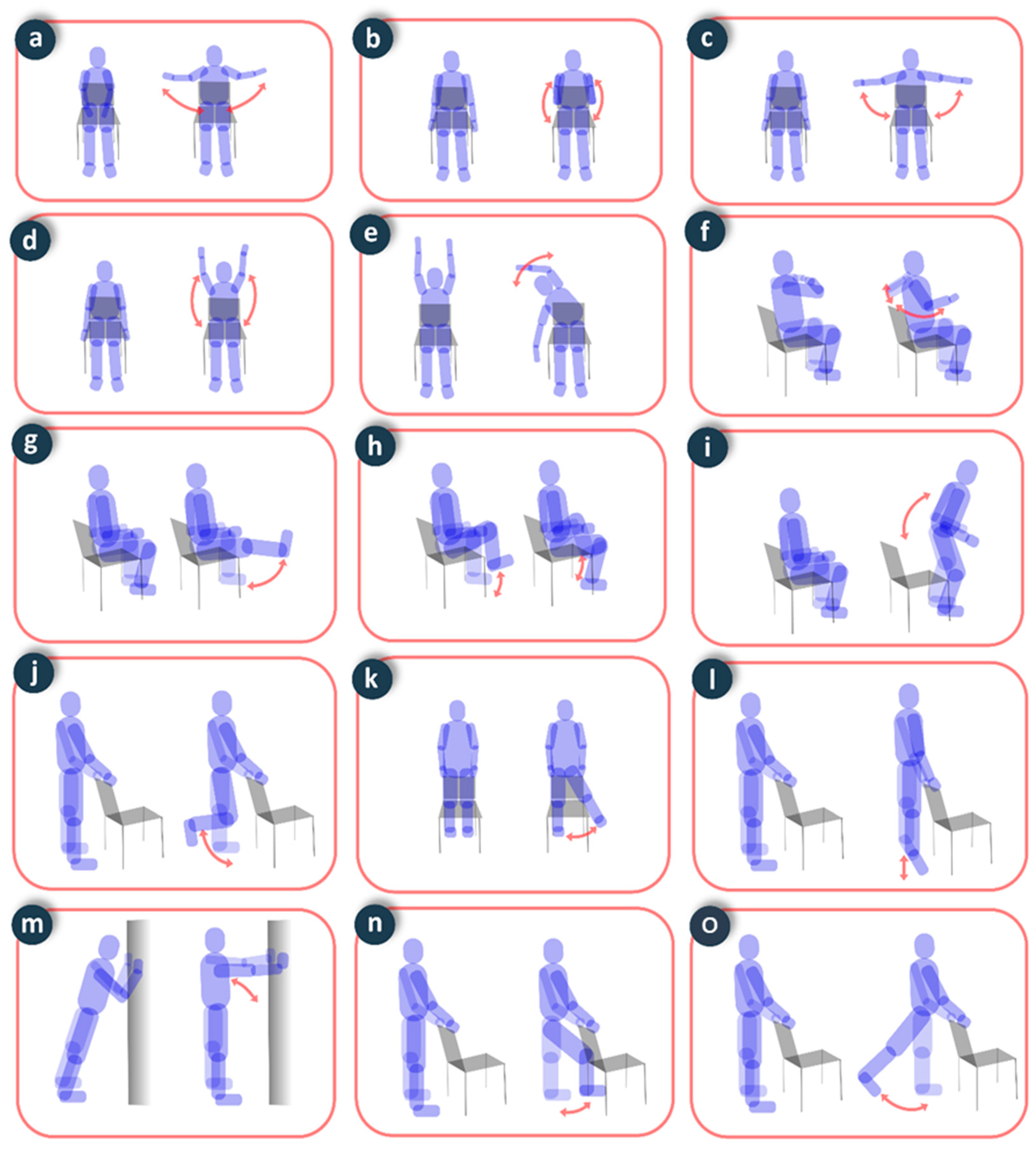

| Goal | Need | Design Requirement |
|---|---|---|
| Daily life support | Continuous monitoring of vital signs | Unobstructive, portable and ease-to-use sensor devices for heart and breathing rate. |
| Risk event support | SOS alert (automated or manual) | |
| Physical exercise interventions | Gamification platform with personalized exercises | |
| Maintain adherence to interventions | Feedback and coaching | |
| Avoid falls | Falls detector | Sensor device monitoring physical activity and falls risk |
| Continuity of care | Remote supervision of health status | Storage of and access to monitoring data |
| Notification of event risks | Alert delivery to each stakeholder | |
| Supervision of physical performance | Automatic performance assessment |
| Category | Parameters | Default Value |
|---|---|---|
| Anthropometric | Weight (kg) | N/A |
| Birth date | N/A | |
| Gender | N/A | |
| Height (cm) | N/A | |
| Thorax perimeter (cm) | N/A | |
| Fall detection config. | Vertical posture threshold | 6.5 m/s2 |
| Fall energy threshold | 0.079 m2/s4 | |
| Physical activity config. | Horizontal posture threshold | 2.5 m/s2 |
| Movement activity energy threshold | 0.1490 m2/s4 | |
| Resting energy threshold | 0.0306 m2/s4 | |
| Ascending/Descending displacement threshold | 0.1/−0.12 m | |
| Respiratory monitoring config. | Intense motion artifact detection threshold | 3.7 m/s2 |
Publisher’s Note: MDPI stays neutral with regard to jurisdictional claims in published maps and institutional affiliations. |
© 2021 by the authors. Licensee MDPI, Basel, Switzerland. This article is an open access article distributed under the terms and conditions of the Creative Commons Attribution (CC BY) license (https://creativecommons.org/licenses/by/4.0/).
Share and Cite
Calvillo-Arbizu, J.; Naranjo-Hernández, D.; Barbarov-Rostán, G.; Talaminos-Barroso, A.; Roa-Romero, L.M.; Reina-Tosina, J. A Sensor-Based mHealth Platform for Remote Monitoring and Intervention of Frailty Patients at Home. Int. J. Environ. Res. Public Health 2021, 18, 11730. https://doi.org/10.3390/ijerph182111730
Calvillo-Arbizu J, Naranjo-Hernández D, Barbarov-Rostán G, Talaminos-Barroso A, Roa-Romero LM, Reina-Tosina J. A Sensor-Based mHealth Platform for Remote Monitoring and Intervention of Frailty Patients at Home. International Journal of Environmental Research and Public Health. 2021; 18(21):11730. https://doi.org/10.3390/ijerph182111730
Chicago/Turabian StyleCalvillo-Arbizu, Jorge, David Naranjo-Hernández, Gerardo Barbarov-Rostán, Alejandro Talaminos-Barroso, Laura M. Roa-Romero, and Javier Reina-Tosina. 2021. "A Sensor-Based mHealth Platform for Remote Monitoring and Intervention of Frailty Patients at Home" International Journal of Environmental Research and Public Health 18, no. 21: 11730. https://doi.org/10.3390/ijerph182111730
APA StyleCalvillo-Arbizu, J., Naranjo-Hernández, D., Barbarov-Rostán, G., Talaminos-Barroso, A., Roa-Romero, L. M., & Reina-Tosina, J. (2021). A Sensor-Based mHealth Platform for Remote Monitoring and Intervention of Frailty Patients at Home. International Journal of Environmental Research and Public Health, 18(21), 11730. https://doi.org/10.3390/ijerph182111730






